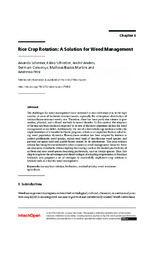Rice Crop Rotation: a solution for weed management.
Rice Crop Rotation: a solution for weed management.
Author(s): SCHERNER, A.; SCHREIBER, F.; ANDRES, A.; CONCENCO, G.; MARTINS, M. B.; PITOL, A.
Summary: The challenges for weed management have increased in rice cultivation due to the high number of cases of herbicide-resistant weeds, especially the widespread distribution of imidazolinone-resistant weedy rice. Therefore, there has been particular interest in preventive, physical, and cultural methods in recent decades. In this context, the adoption of the rice-soybean rotation is reported to be one of the most important factors for weed management in rice fields. Additionally, the use of a diversified crop rotation enables the implementation of a broader herbicide program, which is an important feature influencing weed population dynamics. Rice-soybean rotation has been adopted by farmers to control problematic weed species, reduce seed bank of troublesome weed species, and prevent rice grain yield and quality losses caused by its interference. This crop rotation scheme has brought several benefits when it comes to weed management; however, there are also some drawbacks when adopting this strategy such as the limited productivity of soybean and new weed species becoming problematic, such as Conyza species. Thus, this chapter explores the advantages and disadvantages of adopting crop rotation in Brazilian lowlands, and proposes a set of strategies to successfully implement crop rotation in lowland soils as a tool for weed management.
Publication year: 2018
Types of publication: Book sections
Observation
Some of Embrapa's publications are published as ePub files. To read them, use or download one of the following free software options to your computer or mobile device. Android: Google Play Books; IOS: iBooks; Windows and Linux: Calibre.
Access other publications
Access the Agricultural Research Database (BDPA) to consult Embrapa's full library collection and records.
Visit Embrapa Bookstore to purchase books and other publications sold by Embrapa.

